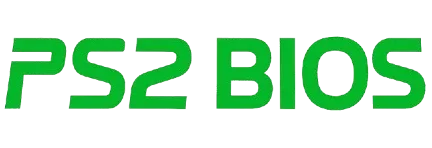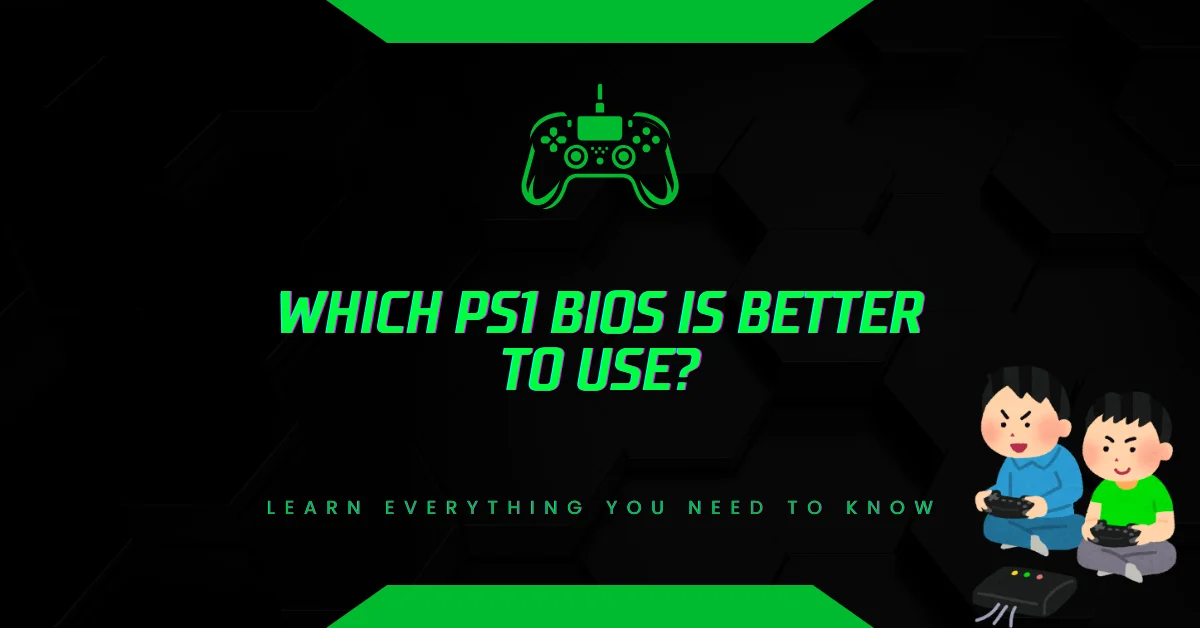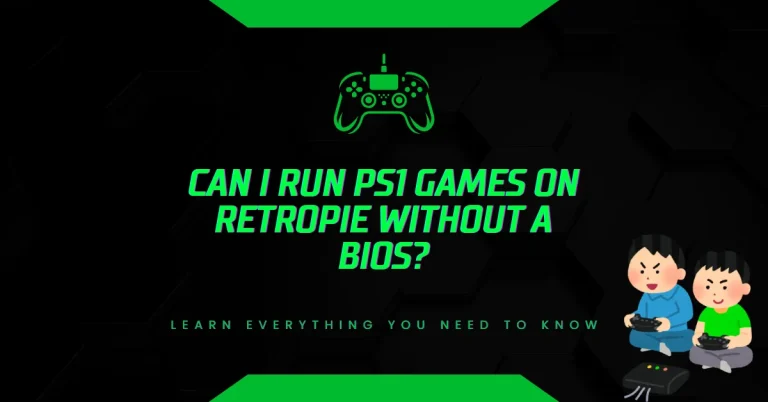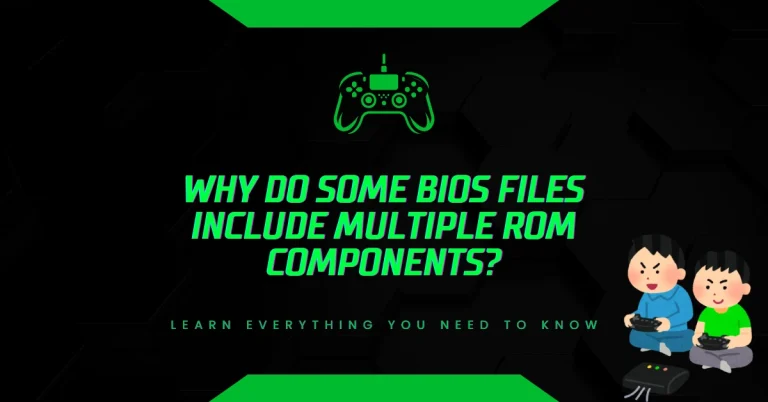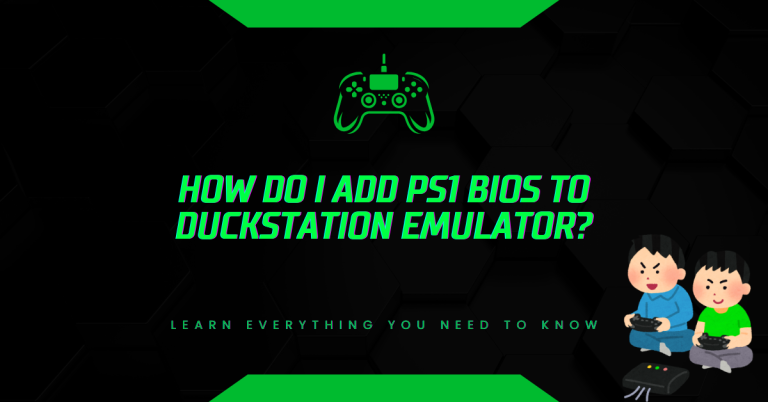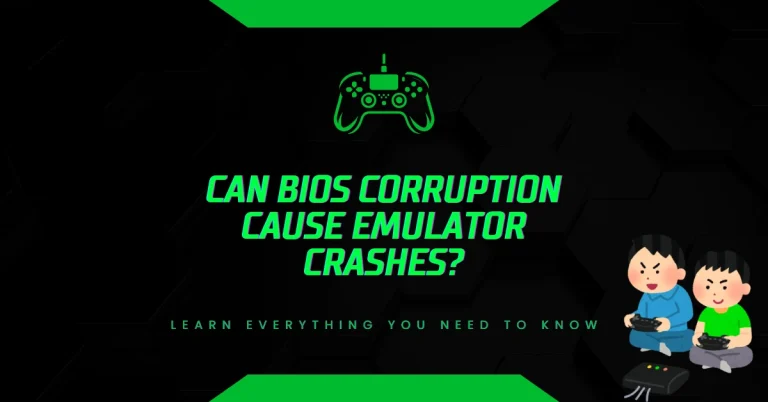Which PS1 BIOS Is Better to Use in 2025? Here’s the Answer
Are your PlayStation 1 games stuttering, freezing, or failing to load on your emulator?
The issue might not be your emulator it’s likely the BIOS. The PlayStation BIOS is essential for accurate emulation.
Using the wrong one can cause glitches, audio problems, and save file errors.
In this guide, you’ll learn exactly which PS1 BIOS is best and how to use it with your emulator, so your games run as they should.
Which PS1 BIOS Is Better to Use in 2025? (Quick Summary)
The best PS1 BIOS to use is SCPH1001 for NTSC-U games due to its high compatibility with emulators like DuckStation and RetroArch. For PAL games, use SCPH7502. Always dump your own BIOS from a real console for legal use and better emulator accuracy. Avoid using unverified BIOS downloads.
What Is a PS1 BIOS?
A PlayStation 1 BIOS (Basic Input Output System) is the internal startup software built into the original Sony PS1 console.
It runs checks on the hardware, reads game discs, and controls memory card access. BIOS files are required for emulators like RetroArch, ePSXe, and DuckStation to properly boot and play games.
When you use an emulator without a valid BIOS file, the system may not function correctly. Games may refuse to start, freeze during gameplay, or display corrupted audio and video.
That’s why choosing the right BIOS file is a key step in building a reliable emulator setup.
Why the BIOS File Is Critical?
The PS1 BIOS plays a big role in accurate emulation. Here’s why it matters:
- Game Compatibility: Many games won’t run unless the correct BIOS is loaded. Some may boot but freeze during cutscenes or gameplay.
- Performance Accuracy: The BIOS ensures sound effects, frame timing, and display output match what you’d see on original hardware.
- Save Functionality: Without a proper BIOS, saving and loading your progress can fail or produce corrupted files.
- Region Support: BIOS files are region-specific (NTSC-U, NTSC-J, PAL). Using the wrong one often causes problems.
What are the Common PS1 BIOS Files and When to Use Them?
Each BIOS file version reflects a different region or hardware revision. Let’s break down the most popular BIOS files and when to use each one:
1. SCPH-1001 – Best for NTSC-U (North America)
- Region: United States and Canada
- Emulator Support: Works seamlessly with ePSXe, DuckStation, and RetroArch
- Why Use It: Known for excellent compatibility and stability with North American games
- File Size: ~512 KB
- MD5 Hash: 924e392ed05558ffdb115408c263dccf
2. SCPH-5501 – Reliable Alternative for NTSC-U
- Performs almost as well as SCPH-1001
- Slightly newer firmware version
- Useful if SCPH-1001 is missing or fails to work
- MD5 Hash: 490f666e1afb15b7362b406ed1cea246
3. SCPH-7001 – Later NTSC-U Revision
- Another North American BIOS with updated internal functions
- Less commonly used in emulator setups but still compatible
4. SCPH-7502 – Best for PAL Regions (Europe, Australia)
- Region: United Kingdom, Germany, France, etc.
- Needed for games released in PAL format, which uses different timing and video standards
- MD5 Hash: 2bfd74ba00d36eb6b2a54d9c5b6848a0
5. SCPH-1000 / 3000 / 5000 Series – Ideal for NTSC-J (Japan)
- Required for Japanese PlayStation games
- Helps prevent boot errors, language issues, and unusual game behavior
- Recommended if you play import titles from Japan
How to Choose the Right PS1 BIOS?
To avoid errors, follow this simple guide when picking your BIOS:
| Game Region | Recommended BIOS |
| NTSC-U (US/Canada) | SCPH-1001 or SCPH-5501 |
| PAL (Europe) | SCPH-7502 |
| NTSC-J (Japan) | SCPH-1000 / 3000 / 5000 Series |
BIOS Compatibility by Emulator
Not every emulator handles BIOS files the same way. Here’s how the most popular ones work:
ePSXe
- Best with SCPH-1001
- Manual BIOS selection required
- BIOS file goes in bios folder
- File must end in .bin (e.g., scph1001.bin)
RetroArch
- Supports multiple BIOS files
- Place BIOS files in the system folder
- Filenames must match exactly (e.g., scph5501.bin)
- Restart RetroArch if BIOS is not detected
DuckStation
- Automatically scans and selects matching BIOS for the game region
- BIOS files can be imported via Settings > BIOS
- Works well with SCPH-1001, SCPH-7502, and SCPH-7003
How to Add Multiple BIOS Files?
If you plan to play games from different regions, it’s smart to include all relevant BIOS files. Most emulators let you store multiple BIOS versions in one folder.
Here’s a suggested setup:
bash
/bios/scph1001.bin ← NTSC-U
/bios/scph7502.bin ← PAL
/bios/scph7003.bin ← NTSC-JThis allows your emulator to automatically select the correct BIOS based on the region of the game you load.
How to Check BIOS Integrity with MD5 or SHA1?
To ensure your BIOS file isn’t corrupted, you can verify it using an MD5 hash checker:
- Download a free tool like WinMD5Free or HashCalc
- Run the tool and select your BIOS file
- Compare the result with known MD5 values
Example:
- SCPH-1001 MD5: 924e392ed05558ffdb115408c263dccf
- SCPH-7502 MD5: 2bfd74ba00d36eb6b2a54d9c5b6848a0
This helps you avoid emulator crashes caused by damaged or fake BIOS files.
How to Tell If Your BIOS Is Working?
Method 1: Load a Known Working Game
Try starting a title like Crash Bandicoot, Final Fantasy VII, or Tekken 3. If you see the PlayStation logo and reach the title screen, the BIOS is working.
Method 2: Emulator Logs or Settings
Most emulators will show a message if the BIOS is missing or incorrectly configured. You can also look in the settings or logs to confirm that a valid BIOS is detected.
What are the Problems That Happen with the Wrong BIOS?
If your BIOS file is wrong, damaged, or from the wrong region, you may run into:
- Black screen or stuck boot screen
- In-game crashing or freezing
- Missing or garbled sound
- Broken save/load functionality
- Games running at the wrong speed or with display issues
Correcting the BIOS usually solves these issues instantly.
Where to Place the BIOS File? (Emulator Paths)
| Emulator | Folder Location | File Naming Tips |
| ePSXe | /bios/ inside ePSXe directory | Use .bin format (e.g., scph1001.bin) |
| RetroArch | /system/ folder | Exact filename match required |
| DuckStation | Any user-defined folder | BIOS auto-detection supported |
Always restart your emulator after adding a new BIOS file to apply the changes.
Dumping Your Own PS1 BIOS (The Legal Way)
To stay on the legal side, you can dump the BIOS directly from your own PlayStation console.
You’ll need:
- A PlayStation 1 console
- A memory card
- A homebrew loader like Caetla, UniROM, or Xplorer
- A transfer method (e.g., USB adapter or PS3 memory card reader)
This method gives you a legal and authentic BIOS that’s guaranteed to work.
Step-by-Step: How to Dump PS1 BIOS?
Let’s break it down into simple steps you can follow:
Step 1: Insert Your Memory Card
Turn on your PS1 and make sure the memory card is properly inserted. This is where the BIOS file will be saved after dumping.
Step 2: Load Homebrew Software
You need to run a BIOS dumping program like UniROM, Caetla, or Xplorer. Here’s how:
- If your PS1 has a modchip, simply boot from a burned disc with the software.
- If not, use a cheat cartridge like Action Replay or GameShark that supports custom firmware like Caetla.
- You can also use the disc swap trick or a flashed memory card loaded with UniROM.
Once loaded, these tools allow your console to read its own BIOS and save it.
Step 3: Dump the BIOS to Memory Card
Inside the tool’s menu, choose the “Dump BIOS” or similar option. The program will:
- Read the BIOS chip from your console
- Save a file (often named bios.bin) to the memory card
- Make sure your memory card has at least 512KB free this is the size of the BIOS file
Step 4: Transfer BIOS File to PC
Now that your BIOS is saved, it’s time to move it to your computer. You can do this using:
- A PlayStation 3, which can read PS1 memory cards and export files via USB
- A USB memory card adapter
- A PC tool like MemCardRex, which reads PS1 memory card saves
Once the file is on your computer, save it in a safe place. You can now load it into emulators like DuckStation, PCSX-R, or RetroArch for accurate PlayStation emulation.
Final Thoughts
Using the right PS1 BIOS is essential for playing games smoothly on your emulator. For most North American users, SCPH-1001 is the best option. If you’re in Europe, go with SCPH-7502, and for Japanese titles, use SCPH-1000, 3000, or 5000.
Make sure your BIOS file matches the game region, is placed in the correct folder, and has the right filename. Verifying it with an MD5 tool is also smart to avoid crashes or corrupted files. When everything is set up properly, you’ll get a gaming experience that feels just like the real PlayStation.
Extra Tip: Don’t forget to back up your BIOS files and save states regularly. It’ll save you a lot of time if anything goes wrong.

Hi, I’m Leo Whitmore, author at bios-ps2.com. I’m passionate about gaming and tech. I love helping others enjoy retro gaming through simple guides and tools. Here, I share tips to make emulation easy and fun for everyone.
Contents
- 1 Which PS1 BIOS Is Better to Use in 2025? (Quick Summary)
- 2 What Is a PS1 BIOS?
- 3 Why the BIOS File Is Critical?
- 4 What are the Common PS1 BIOS Files and When to Use Them?
- 5 How to Choose the Right PS1 BIOS?
- 6 BIOS Compatibility by Emulator
- 7 How to Add Multiple BIOS Files?
- 8 How to Check BIOS Integrity with MD5 or SHA1?
- 9 How to Tell If Your BIOS Is Working?
- 10 What are the Problems That Happen with the Wrong BIOS?
- 11 Where to Place the BIOS File? (Emulator Paths)
- 12 Dumping Your Own PS1 BIOS (The Legal Way)
- 13 Step-by-Step: How to Dump PS1 BIOS?
- 14 Final Thoughts
